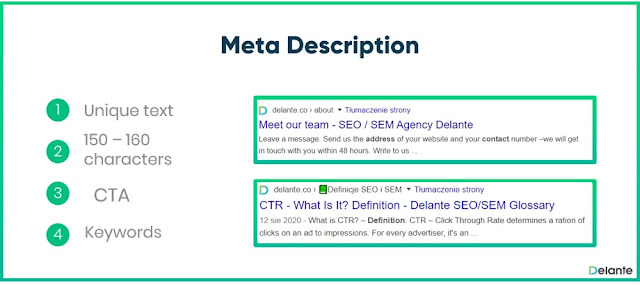META DESCRIPTION IN SEO: The meta description is an HTML tag that provides a brief summary of a webpage's content. It appears in search engine results and provides context to users about what the page is about.
It is important for SEO (Search Engine Optimization) because it can affect the click-through rate from search results, as well as help search engines understand the content of a page. A well-written meta description should be concise, relevant, and include relevant keywords.
Use of meta description
META DESCRIPTION IN SEO: The meta description is used in search engine optimization (SEO) as a way to give a brief summary of what a webpage is about. It appears in search engine results below the page title and provides a snippet of information to help users determine whether the page is relevant to their search query.
A well-written meta description can improve the click-through rate from search results to a webpage, as it gives users a reason to click and visit the site. Search engines also use the meta description as a factor in ranking pages, so having a relevant and compelling description can help improve a website's search engine visibility.
In summary, the use of meta descriptions can:
- Provide context for users about the content of a page
- Encourage users to click on a page from search results
- Improve a website's search engine visibility and ranking.
Meta description is really needed for every post and page
META DESCRIPTION IN SEO: Yes, it is recommended to include a meta description for every post and page on a website. While meta descriptions are not a direct ranking factor, they can still have an impact on a website's search engine optimization (SEO).
Having a meta description for each page provides additional information to search engines about the content of a page, which can help with indexing and ranking. It also helps users make informed decisions about whether to click on a page from search results, as the meta description provides a snippet of information about the page's content.
However, it's important to note that meta descriptions should be unique and relevant to each page, as generic or irrelevant descriptions can negatively affect the user experience and potentially lead to lower click-through rates from search results.
How to use Meta description
META DESCRIPTION IN SEO: Here are the steps to use a meta description effectively:
- Determine the main topic and focus of the page: The meta description should provide a brief summary of what the page is about.
- Write a concise, descriptive summary: A meta description should be concise and clearly explain what the page is about. Aim for a length of 150-160 characters.
- Include relevant keywords: Including relevant keywords in the meta description can help the page rank higher in search engine results for those keywords.
- Make it unique: Each page on a website should have a unique meta description that accurately reflects the content of that page.
- Add the meta description to the page's HTML code: The meta description can be added to the HTML code of a page using the "meta" tag. It should be placed within the "head" section of the code and include the "name" attribute set to "description" and the "content" attribute with the desired text.
Example
Copy code
<head>
<meta name="description" content="This is a sample meta description for a webpage.">
</head>
By following these steps, you can use the meta description to improve a page's visibility in search results, encourage clicks from users, and provide a better user experience.
Example of meta description used as effective manner to drive traffic
META DESCRIPTION IN SEO: Here is an example of a meta description that could be used to effectively drive traffic to a website:
Imagine you have a travel blog that focuses on budget-friendly travel tips. For a post about budget-friendly destinations in Europe, you could use the following meta description:
<head>
<meta name="description" content="Discover the best budget-friendly destinations in Europe for your next trip. Get insider tips on saving money and exploring like a local.">
</head>
This meta description accurately reflects the content of the post and includes relevant keywords, such as "budget-friendly," "Europe," and "travel tips." It also provides a compelling reason for users to click on the post from search results, as it promises insider information on saving money and exploring like a local.
By using a well-crafted meta description, you can increase the chances of users clicking on your post from search results and visiting your website, which can drive more traffic and potentially lead to increased engagement and conversions.
Advantages of meta description
META DESCRIPTION IN SEO: There are several advantages of using a meta description, including:
- Improved visibility in search results: A well-written meta description can help a page rank higher in search results, as it provides additional context to search engines about the content of a page.
- Increased click-through rate: A compelling meta description can entice users to click on a page from search results, which can drive more traffic to a website.
- Better user experience: A clear and relevant meta description can improve the user experience by giving users a better understanding of what a page is about before they click through to the site.
- Ability to target specific keywords: Including relevant keywords in a meta description can help a page rank higher in search results for those keywords.
- Increased brand awareness: A consistent and compelling meta description can help reinforce a brand's messaging and improve brand awareness, as users will see the description in search results.
Limitations of meta description
META DESCRIPTION IN SEO: There are a few limitations of using a meta description, including:
- Limited impact on search rankings: Although a well-written meta description can help a page rank higher in search results, it is not a direct ranking factor. Other factors, such as content relevance and quality, are more heavily weighted.
- Truncation in search results: Search engines may truncate meta descriptions that are too long, potentially leading to a loss of context or relevance.
- No guarantee of display: Search engines may choose to ignore the meta description and display alternative text in search results, such as content from the page or a different description.
- Inconsistent use by search engines: Different search engines may display meta descriptions differently in search results, which can impact the visibility and effectiveness of a description.
- Potential for lower click-through rates: A poorly written or irrelevant meta description can actually decrease the click-through rate from search results, as users may not be motivated to click on the page.
How to write a perfect meta description for website
META DESCRIPTION IN SEO: Here are some tips to help you write a perfect meta description for a website:
- Be concise: Aim for a length of around 150-160 characters, as longer descriptions may be truncated in search results.
- Clearly describe the content of the page: The meta description should provide a brief summary of what the page is about.
- Use relevant keywords: Including relevant keywords in the meta description can help the page rank higher in search results for those keywords. However, avoid keyword stuffing, as this can negatively impact the visibility of a page.
- Make it unique: Each page on a website should have a unique meta description that accurately reflects the content of that page.
- Write for humans, not just search engines: The meta description should be written in a way that is compelling and relevant to users, as well as search engines.
- Avoid duplicate descriptions: Duplicate meta descriptions across multiple pages can result in lower visibility in search results, as search engines may view the content as spam.
By following these tips, you can write a perfect meta description that improves the visibility and ranking of a website, encourages users to click through from search results, and provides a better user experience.
What are mistakes that should be avoided during meta description
META DESCRIPTION IN SEO: Here are some common mistakes to avoid when writing a meta description:
- Keyword stuffing: Including too many keywords in a meta description can make it sound unnatural and spammy, and can result in lower visibility in search results.
- Duplicate descriptions: Duplicate meta descriptions across multiple pages can result in lower visibility in search results, as search engines may view the content as spam.
- Overlooking meta descriptions: Neglecting to include a meta description, or including a generic or irrelevant description, can result in lower visibility and click-through rates in search results.
- Making them too short or too long: Aim for a length of around 150-160 characters, as longer descriptions may be truncated in search results, and shorter descriptions may not provide enough context.
- Not using keywords: Not including relevant keywords in the meta description can make it harder for a page to rank in search results for those keywords.
- Not writing for humans: The meta description should be written in a way that is compelling and relevant to users, not just search engines.
By avoiding these common mistakes, you can ensure that your meta descriptions are effective in driving traffic to your website and improving the visibility and ranking of your pages.












0 Comments